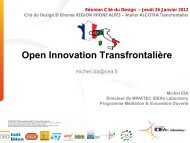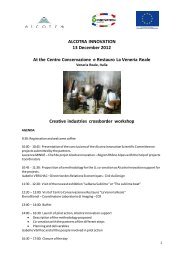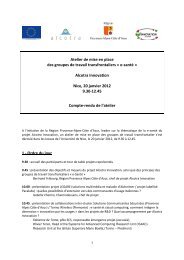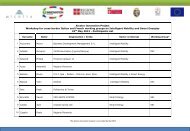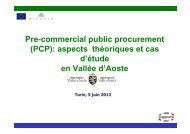Best practices Database for Living Labs - ALCOTRA - Innovation
Best practices Database for Living Labs - ALCOTRA - Innovation
Best practices Database for Living Labs - ALCOTRA - Innovation
Create successful ePaper yourself
Turn your PDF publications into a flip-book with our unique Google optimized e-Paper software.
1. Introduction<br />
Much has been written about the massive explosion of <strong>Living</strong> <strong>Labs</strong> that has positively affected the European<br />
scenario in the past five years now. Scientists, industry observers, and policy makers seem to share the<br />
perception that the big movement (and momentum) still under way defies meaningful descriptions, making<br />
an overall evaluation almost impossible. This perception is un<strong>for</strong>tunate, because the ‘essence’ of European<br />
<strong>Living</strong> <strong>Labs</strong> – a successful mixture of ICT-based collaborative environments, open innovation plat<strong>for</strong>ms, user<br />
centered product/service development methods, and public private partnerships – holds potentially<br />
disruptive and long lasting trans<strong>for</strong>mational effects on industry, markets, regional economies and societal<br />
landscapes.<br />
On November 20 th , 2006, the Finnish EU Presidency launched the idea of a European Network of <strong>Living</strong> <strong>Labs</strong><br />
(ENoLL) <strong>for</strong> the “co-creation of innovation in public, private and civic partnership”. This was presented as a<br />
first step towards a new European R&D and <strong>Innovation</strong> System, entailing a major paradigm shift <strong>for</strong> the<br />
whole innovation process. Since then, a growing number of European actors in a variety of business and<br />
non-business domains, have understood that involving people into product and service creation is of vital<br />
importance <strong>for</strong> the acceptance and marketability of results. This has led to the launch of six non-funded<br />
calls (the one currently open expires on February 28 th , 2012) and the acknowledgment of five consecutive<br />
“waves” of <strong>Living</strong> <strong>Labs</strong>, endorsed by the Portuguese, Slovenian, French, Swedish, Spanish and Hungarian<br />
Presidencies, bringing the 19 founding members of the ENoLL to 274 (including 47 non-EU <strong>Living</strong> <strong>Labs</strong> from<br />
e.g. North and South Africa, Australia, Brazil, Canada, China, Colombia, and the US). A subset of these has<br />
also given life, in January 2010, to the ENoLL aisbl international non-profit association, holding its seat in<br />
Brussels.<br />
In essence, the <strong>Living</strong> Lab concept refers to a set of (quantitative and qualitative) methodologies and tools<br />
<strong>for</strong> the co-creation and validation of innovation together with the end users in real-world environments. In<br />
these environments, people are taken across the different roles played during a normal day, and which<br />
typically require the use and support of different technologies. Compared with traditional testbeds, where<br />
users are not necessarily involved and the laboratory setting is controlled, <strong>Living</strong> <strong>Labs</strong> place people at the<br />
very centre of the innovation process; thereby, innovation becomes human-centric, in contrast to<br />
technology-centric. Further to that, <strong>Living</strong> Lab activities go on round the clock: this means that solution<br />
developers get the opportunity to gain understanding of a new product or service in its 24/7 usage context.<br />
Finally, in the perspective of validation, the focus is on how users experience technology, e.g. by interfacing<br />
design and ergonomics, as well as on user acceptance. Hence, the purpose of a <strong>Living</strong> Lab is to enhance<br />
innovation, usefulness, and usability of ICT applications in society.<br />
To date, evidence collection on current and emerging <strong>Living</strong> <strong>Labs</strong> has largely relied on self-reflection and<br />
some empirical analyses carried out on relevant, yet partial subsets of the movement. However, this has<br />
contributed to highlight the complexity of a European ‘phenomenon’ which is characterized, at the very<br />
least, by a great deal of variability in the respective aims, methods, tools, activities and results. In this<br />
context, time is ripe <strong>for</strong> an integrated research agenda, which aims to fill in the vacuum between<br />
theoretical developments and practical implementations, and lay the scientific basis <strong>for</strong> what can be<br />
recognized as ‘the’ first truly original model of innovation ever appeared in Europe.<br />
As a preliminary contribution in that direction, this paper proposes a survey of all 274 <strong>Living</strong> <strong>Labs</strong> that are<br />
currently members of the ENoLL, based on textual in<strong>for</strong>mation kindly made available by the ENoLL aisbl<br />
chair. The survey was carried out, when available, on the individual self-descriptions delivered by the<br />
candidates to the various ENoLL “waves”, otherwise on the <strong>Living</strong> Lab profiles that are published on the<br />
www.openlivinglabs.eu website. No attempt has been made to contact any <strong>Living</strong> Lab directly <strong>for</strong> a<br />
clarification or integration of the received and analyzed in<strong>for</strong>mation. While this approach may lend itself to<br />
criticisms, as it leaves a lot of margin to the discretional interpretation of the researcher, we believe it also<br />
comes as close as possible to what can be said to be an objective and neutral presentation of the <strong>Living</strong> Lab<br />
The project is co-funded by the ERDF<br />
Page 7 of 78



